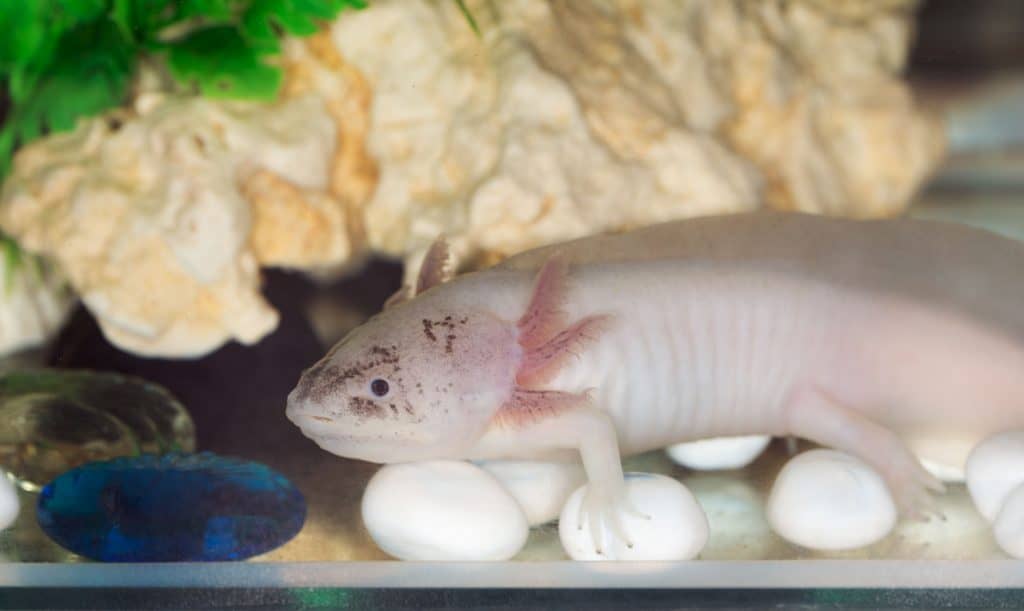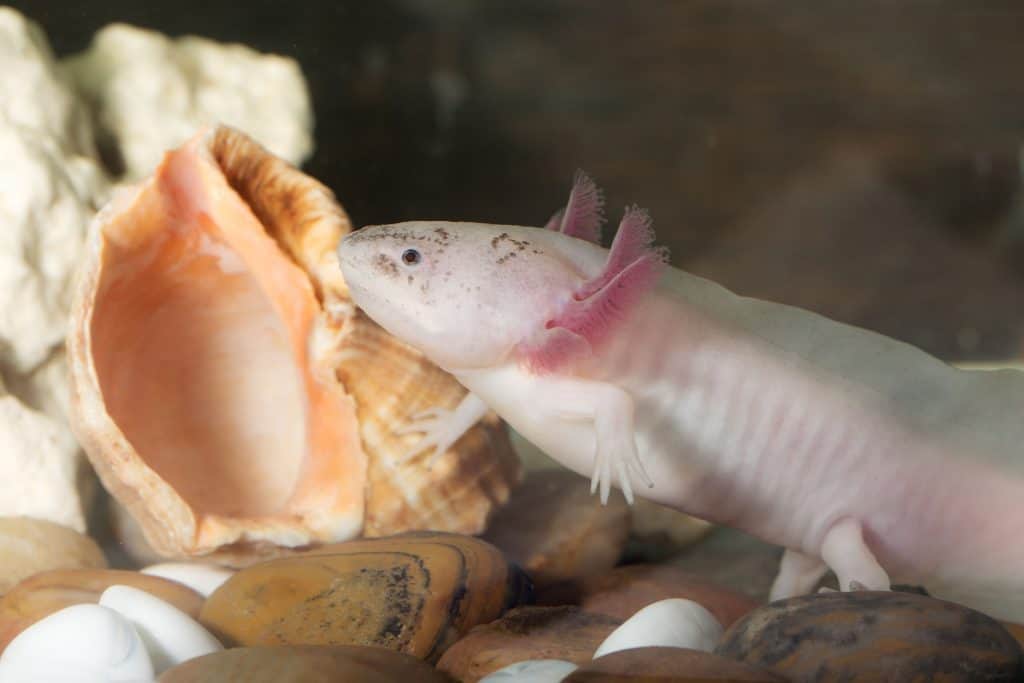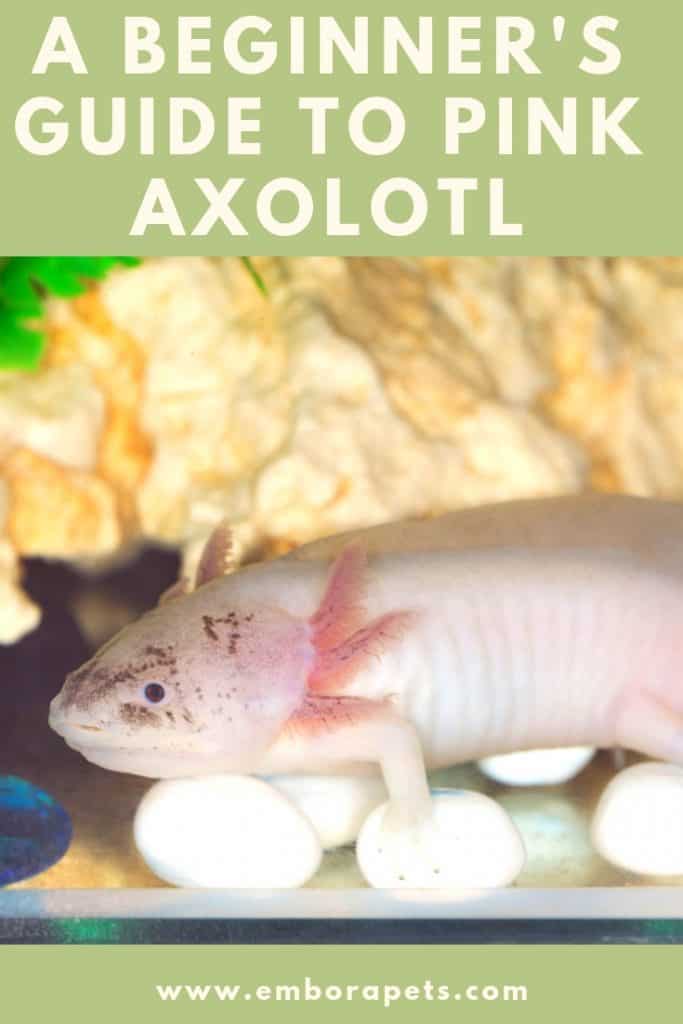Pink Axolotl: A Beginner’s Guide with Pics, Cost to Buy, and Care Info

Axolotls are a big animal on the internet right now. Many people, including myself, are wondering what they are and if they make good pets. Here is some research I found about what they are, how much they cost, and how to take care of them.
What should I know about pink axolotl?
A Pink Axolotl is a salamander species A.K.A. the Mexican Walking Fish. They cost between $20-$45 depending on age. They need a 15-20 gallon tank with cool water away from sunlight, and a water filter. They need to be fed once a day for young Axolotls, and every other day for full-grown Axolotls.
To learn more about what Pink Axolotls are, where and how much you can buy them for, and how to properly take care of them, continue reading
What is a Pink Axolotl?
A Pink Axolotl is part of the Salamander species. They are also known by the name, “Mexican Walking Fish”.
More and more people are starting to show interest in having these Pink Axolotls as pets. They are easy to care for and compare to the difficulty level of a fish.
They usually live anywhere from 10 to 15 years but have been known to live past 20 years in some cases. Make sure that is you are considering buying an Axolotl as a pet that you consider the commitment to the time of having this animal.
Adult Axolotls usually grow up to about 9 inches on average at peak sexual maturity. Anything past 12 inches is possible but, rarer. They have been known to get up to around 18 inches though, and can be as samll as 6 inches, but that is also rare.
Axolotls are aquatic animals and need to be kept in water to be able to survive. In the wild they live in freshwater lakes in Mexico, but when kept as pets in captivity they live in large aquarium enclosure with a smooth substrate.
The Axolotls are native to two lakes in Mexico, Lake Xochimilco, and Lake Chalco. Lake Chalco no longer exists, and Lake Xochimlco, is left to only canals. This is putting the Axolotls species in danger. They are officially on the threatened species list.
Because Axolotls are from the Salamander family, they also have the regenerative ability. They have been known to regenerate limbs, and even parts of their brain.
Axolotls come in many different color moprhs. One of the most popular being the Pink Axolotls, more scientifically known as the Leucistic Axolotl. The skin color is a genetic trait and comes from the parents, much like the fur color of a dog, or the hair color of a person, the same determines axolotl colors.
How Much Does A Pink Axolotl Cost?
Pink axolotls are one of the most common colors, so they are generally pretty affordable. Pink axolotls cost about $25-$45, depending on their age, size, and that particular specimen’s other characteristics.
Where can you buy a Pink Axolotl, and How much do they cost?

You can usually buy Axolotls from exotic pet shops, or Axolotl breeders. Call ahead and make sure that wherever you are going to has Pink Axolotls, or whatever you are looking for.
It is advised to not buy Axolotls from online, or any “black market” source. Make sure where you are buying from is a reputable place. As Axolotls are illegal in some places.
They are legal in most states in the United States with the exception of:
- California
- Maine
- New Jersey
- Virginia
- New Mexico ( They are legal to own in New Mexico, but it is illegal to import them in from other states.)
Pink Axolotls themselves usually range anywhere from 20 dollars to 45 dollars. The younger the Axolotl, usually the cheaper. Juvenile Axolotls are usually in the 20 dollar range, and the adults are usually in the 30 dollar range but can be priced more or less depending on demand.
There are also supplies that need to be purchased in order to be prepared for your new Axolotl.
They need a 15 to 20 gallon tank, which is usually priced around 50 to 90 dollars, depending on quality. They also need a water filter to keep the water clean which costs about 15 dollars.
All around for supplies and the Pink Axolotl itself, you are looking around 120 to 170 dollars in cost, not including food for your pet each month. But, even with these expenses, it tends to be one of the cheaper pets on the market making it more accessible to most people.
How to Take Care of a Pink Axolotl
Pink Axolotls are one of the easier pets to take care of, as they require little attention and maintenance and are not prone to many illnesses.
First things first, they need an environment to live in. They are underwater animals that need a decent sized tank. Although the axolotl tank should be somewhere between 15 to 20 gallons, it doesn’t need to be all the way full. It just needs to be at least as deep as the length of the Axolotl it is housing.
There also needs to be a water filter in the tank to get keep water clean. This will keep the tank from getting dirty, and the Axolotl getting sick. The tank should also be deep cleaned once every couple of months as well, to get rid of any bacteria.
The water in the tank should stay at about 66 to 68 degrees in the warmer months and about 60 to 65 degrees in the colder months. The water should stay cool, and the tank should stay in a darker environment away from too much sunlight.
The tank also needs something on the bottom. Because Axolotls eat just about anything they can swallow, gravel is not recommended for them. Sand is a much more appropriate and safe option for your axolotl. They need a covering for the bottom of their tank so it is easier for them to move around and be comfortable, and simulate their natural environment.
Axolotls are carnivores and predators, meaning they eat meat. Some things that they prefer to eat are brine shrimp, insects, insect larvae, small crustaceans, small fish, earthworms, and other prey, or little cut up pieces of meat such as, liver or beef.
When they are young, they usually eat more to keep them growing and strong. They will usually eat about one cut up earthworm a day, or the equivalent of other food. When they get to be full grown, they will eat about the same every other day, or once every three days.
If the Axolotl isn’t hungry or is full, it will usually spit out the food it doesn’t want. Just be sure to clean leftover food out of the tank to keep it from getting dirty.
When the Axolotls are young they have been known to adapt cannibalistic tendencies. It is a good idea that if you are raising more than one, to keep them in separate tanks until they get older. Although the Axolotls limbs will grow back over a couple of months, these tendencies should not be encouraged.
Do Axolotls Get Along with Other Fish?
It is not advised for fish and axolotls to live together. They can manage, but it is unlikely that one won’t end up dying.
The Axolotls gills have big feathery sides that the fish love to nibble on, causing damage to the Axolotls gills. Potentially causing them to not be able to breathe.
As for the fish, the Axolotls are carnivorous animals. They eat just about anything they can fit in their mouth and swallow whole.
If the fish are smaller, it would be very easy for the axolotl to be able to swallow and eat it.
While they could hypothetically live together, it is not a very smart decision. It would be most wise to either keep the fish and Axolotls in separate tanks, or only have one or the other.
Related Questions:
Are Axolotls Dangerous? While all salamanders have toxins in their skin for self-defense, you would have to ingest the toxin for it to be harmful, such as drinking the tank water or eating the salamander. Be sure to wash your hands after interacting with them (like any other pet) and you should be fine.
Do Axolotls Sleep? Axolotls do rest or sleep to get energy back. They don’t have eyelids, so they don’t close their eyes when resting. They usually just go to a hiding space, slow down their breathing, and don’t move. Try not to disturb them when they are not active.
Are Axolotls Endangered? While Axolotls are not technically considered endangered yet, but because their environment is being threatened, so is their species. They are on the threatened species list. However, the threatened list can easily move to the endangered list.

